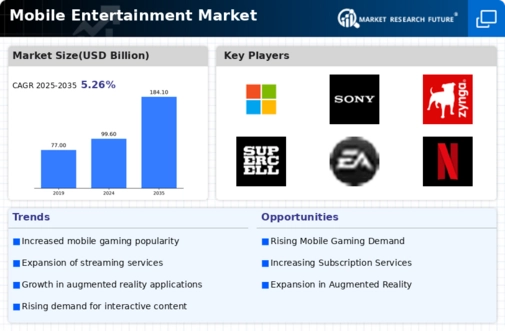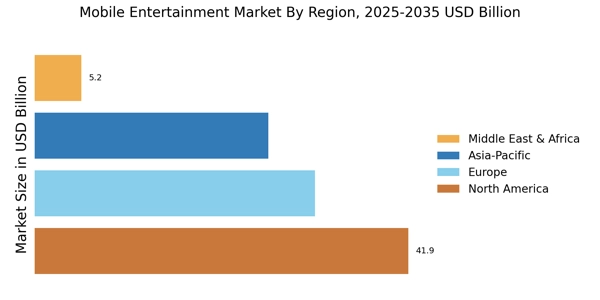Increased Smartphone Penetration
The Mobile Entertainment Market is significantly influenced by the rising penetration of smartphones across various demographics. As more individuals gain access to smartphones, the potential user base for mobile entertainment expands. Recent data indicates that smartphone ownership has reached approximately 80% in many regions, facilitating greater access to mobile applications and services. This trend is particularly pronounced among younger generations, who are more inclined to consume entertainment content on their devices. Consequently, the Mobile Entertainment Market is likely to see a substantial increase in demand for mobile games, streaming services, and social media platforms. The proliferation of affordable smartphones is also contributing to this growth, as it allows users from diverse economic backgrounds to participate in the mobile entertainment ecosystem.
Advancements in Mobile Technology
The Mobile Entertainment Market is experiencing a surge due to rapid advancements in mobile technology. Enhanced processing power, improved graphics capabilities, and high-resolution displays are enabling developers to create more immersive and engaging content. As smartphones become increasingly sophisticated, users are more inclined to engage with mobile entertainment options. For instance, the introduction of 5G technology is expected to revolutionize streaming and gaming experiences, allowing for faster download speeds and reduced latency. This technological evolution is likely to attract a broader audience, thereby expanding the Mobile Entertainment Market. Furthermore, the integration of augmented reality and virtual reality into mobile applications is anticipated to enhance user engagement, making mobile entertainment more appealing and interactive.
Rise of Subscription-Based Models
The Mobile Entertainment Market is witnessing a notable shift towards subscription-based models, which are reshaping consumer behavior and revenue generation. Many streaming services and gaming platforms are adopting subscription models to provide users with unlimited access to content for a fixed monthly fee. This approach not only enhances user retention but also encourages consumers to explore a wider array of entertainment options. Recent statistics suggest that subscription-based services have seen a growth rate of over 20% annually, indicating a strong preference for this model among users. As more companies enter the Mobile Entertainment Market with subscription offerings, competition is likely to intensify, leading to innovative content and pricing strategies that cater to diverse consumer preferences.
Expansion of Mobile Payment Solutions
The Mobile Entertainment Market is benefiting from the expansion of mobile payment solutions, which are streamlining the purchasing process for consumers. As mobile wallets and payment applications become more prevalent, users are increasingly comfortable making in-app purchases and subscriptions. This convenience is likely to enhance user engagement and spending within the Mobile Entertainment Market. Recent data indicates that mobile payment transactions are projected to exceed several trillion dollars in the coming years, reflecting a growing trend towards digital transactions. As payment solutions continue to evolve, they may further facilitate the growth of mobile entertainment services, enabling users to access content seamlessly and encouraging higher spending on entertainment applications.
Growing Demand for Interactive Content
The Mobile Entertainment Market is increasingly characterized by a growing demand for interactive content, which is reshaping how users engage with entertainment. Consumers are seeking experiences that allow them to participate actively rather than passively consume content. This trend is evident in the rise of mobile gaming, where players are not only entertained but also challenged to interact with the game environment. Additionally, platforms that facilitate user-generated content are gaining traction, as they empower users to create and share their own entertainment experiences. This shift towards interactivity is likely to drive innovation within the Mobile Entertainment Market, as developers strive to create more engaging and participatory content that resonates with audiences.


















Leave a Comment